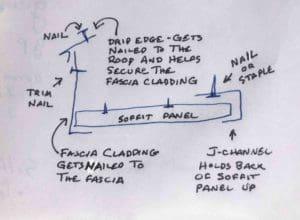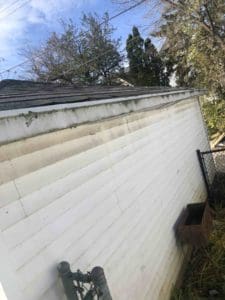Your homes soffit is an important part of a house’s roof system. It’s located on the underside of the roof overhang, and it provides ventilation for the attic space. However, over time, the soffit can start to sag, which can be a major issue. A sagging soffit can look unsightly and compromise the roof’s integrity. In this article, we’ll discuss the top 3 causes for a sagging soffit and how to fix it.
3 reasons for a drooping soffit:
Inadequate Fasteners
Some homeowners wish to think the worst of their contractors and inadequate fasteners would definitely be the worst. Sometimes there just weren’t enough nails, staples, or fasteners to hold the product on. Each type of flashing and element of a maintenance-free home must have the right type of fasteners used. While some may be suitable or even overkill, it’s always better to over-engineer a project than to cut corners.
Improper Gutter Flashing
Gutter flashing is critical to prevent water from getting behind the gutter and running along the fascia. When water runs along the fascia, or, if you have aluminum fascia cladding, between the fascia cladding and the wood fascia, eventually the fascia rots. When the fascia rots, the nails have nothing to grip into.
No Drip Edge Flashing
Non-existent drip edge: This is fairly common among contractors employing shortcuts to trim costs. Because it is common, it is considered to be an acceptable practice, but whether it is ethical is a matter that is beyond the scope of this article. “Drip edge” is a piece of metal that is supposed to be nailed down to the roof decking. In most cases, it is meant to go on the gable (also known as a rake) edges of a house. In some cases, more especially when a house or garage is not going to have gutters installed on that portion of the structure, a desirable option is to substitute it for gutter apron. Either way, you should have either drip edge or gutter apron on every edge of your roof if you are looking for optimal installation. Is the lack of it the installer’s fault? The fault really lies with the homeowner who either hired a company that gave them the cheapest bid. That being said, drip edge should be on every homeowner’s list of requirements on a contract when selecting a roofer.

The exception to the rule: Cedar shake roofs, though unwise from a home maintenance point of view, continue to be not only acceptable but required by certain homeowners associations which prize “natural materials” over durability or a maintenance-free home. Yes, this puts the savvy homeowner into a predicament if they’d rather not be a slave to their home. Drip edge is typically made from aluminum and is therefore not a “natural material”. In those cases, it is not used.
When drip edge is not used on a house with aluminum fascia cladding, high winds can sometimes get underneath the cladding and rip it off from the top. A good drip edge pulls the cladding tight against the underlying wood fascia, reducing the possibility that tearing winds will damage your home.
###
Jim McGuigan is a home improvement specialist living in Wisconsin. His emphasis on building sciences and ability to investigate, catch and solve unusual home improvement challenges, has earned him several industry awards.


